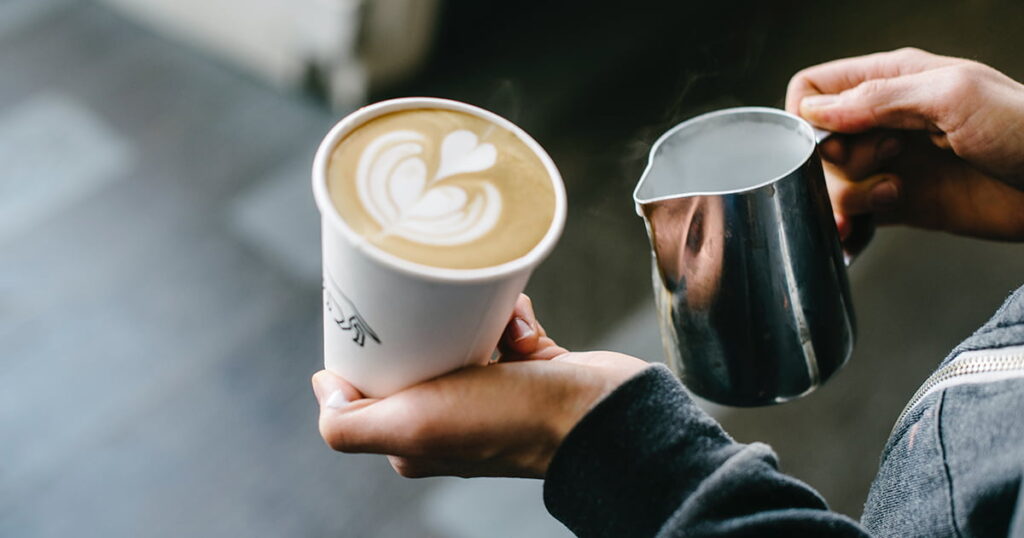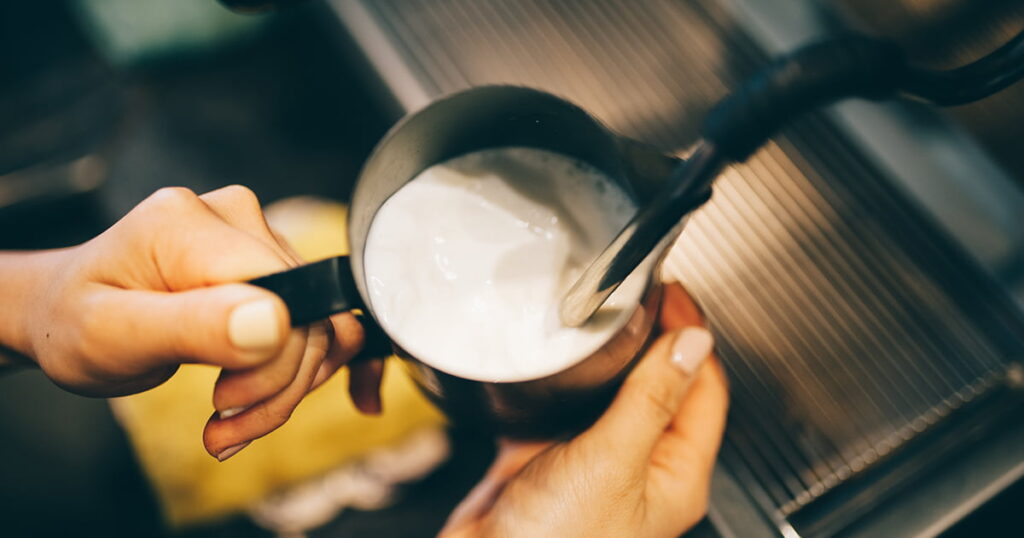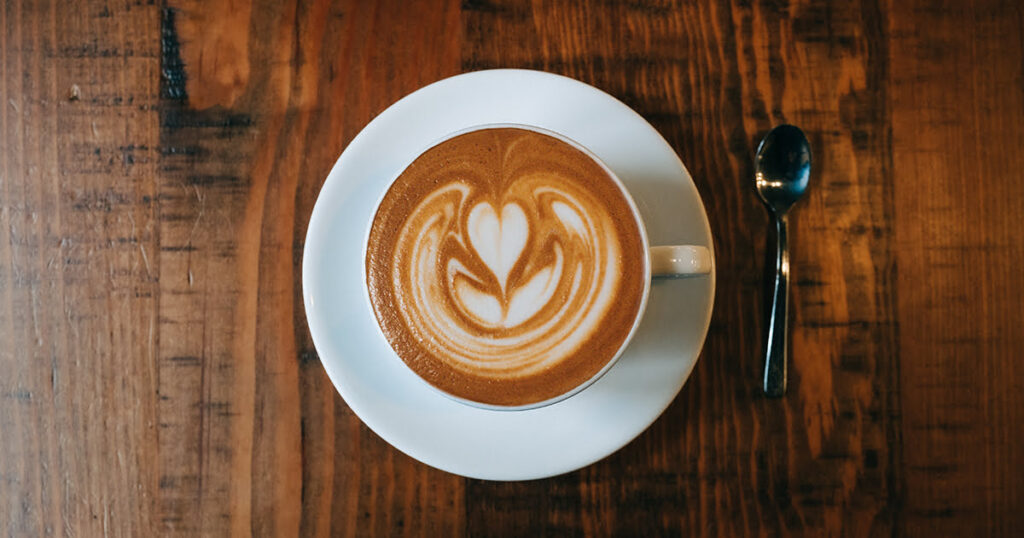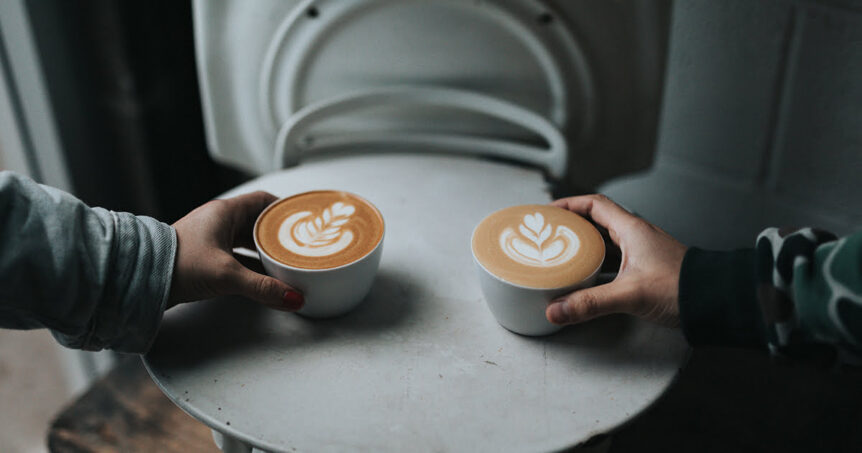In the world of coffee, there are two classic drinks that reign supreme: cappuccino vs latte. But what’s the difference between these two drinks? We will discover their differences and find out which is right for you. Let’s take a closer look at these two classic espresso-based drinks.
| Cappuccino | Latte | |
|---|---|---|
| Main Ingredients | Espresso, Steamed Milk | Espresso, Steamed Milk |
| Serving Temperature | 160-170 °F | 160-170 °F |
| Place of Origin | Italy | America |
| Caffeine per Serving (mg): | ~63mg per single shot | ~63mg per single shot |
What is a Cappuccino?
A cappuccino is a coffee-based drink made from espresso and steamed milk. A thick milk foam layer tops the beverage. It is typically served in a small cup and an accompanying spoon.
The milk foam layer is what gives the cappuccino its signature look and taste. Baristas will aerate milk more for use in a cappuccino. This steaming method creates more “textured” milk foam. This means that there is less milk in the drink due to there being more foam. And many prefer to keep the coffee and milk separated by layering them in the cup. This means the two aren’t heavily mixed with the espresso sitting at the bottom with the foam placed on top.
For Cappuccinos, the espresso flavor is prominent. This makes it a popular choice for coffee lovers looking for an uncompromising espresso beverage.
What is a Latte?

Image credit > M. Cooper from Unsplash
A latte is a coffee-based drink that is also made with espresso and steamed milk. Lattes feature less aerated milk called “micro-foam”. The steamed micro-foam is what gives the latte its rich taste and smooth feel. The added espresso provides more depth to the drink which only makes it richer. It is often served in a glass but also has been popularized as an American to-go beverage.
Lattes are made by pouring the steamed milk directly into the pulled espresso shots. This completely mixes espresso and milk for a very even distribution of both. Sitting on top of the whole beverage is a small layer of thicker, textured foam.
Are Cappuccinos and Lattes the Same?
Cappuccinos and Lattes are very similar but not the same. The proportions of the ingredients are what set these apart.
Both cappuccinos and lattes use the same amount of espresso. The difference is in the milk. Rather, the difference is in how the milk is steamed. Cappuccinos require milk to aerate more to create textured foam. This is a thicker foam that does not mix well with the liquid of espresso. Lattes need steamed micro-foam which does mix well with espresso. Micro-foam is smoother than it is light. Lattes come served in larger cups with more steamed or frothed milk.
The typical proportion of espresso to steamed milk to thick foam for cappuccinos is: 1⁄3 espresso, 1⁄3 steamed milk, and 1⁄3 heavy foam.
The typical proportion of espresso to steamed milk to thick foam for lattes is: ¼ espresso, ½ steamed milk, and ¼ (or less) heavy foamed milk.
What’s the Difference Between Steaming and Frothing Milk?

Image credit > Jack Hishmeh from Unsplash
There are two ways to make foamy milk for drinks like cappuccinos and lattes: steaming and frothing.
https://unsplash.com/photos/FLRMmGOfhMI
Steaming milk is the process of heating milk by injecting steam into milk to heat and aerate it. This creates the best foam for use in lattes and cappuccinos. On the other hand, frothing milk involves using a tool to whisk the milk to create foam. Frothing is best when it can also heat up the milk. Frothed foam tends to be billowy with less micro-foam.
Can You Put Syrup into Lattes and Cappuccinos?
Whether you’re a barista or just love making coffee at home, you’ve probably wondered if you can put syrup in lattes and cappuccinos. The answer is yes! Syrup can add sweetness and flavor to your favorite coffee drinks.
Lattes tend to get the syrup treatment more often since they are a sweeter coffee drink, to begin with. Lattes also mix all the ingredients better which helps with adding syrup to the whole drink.
Cappuccinos are less likely to be served with a sweetener or syrup, but it can be done. The syrup won’t mix well, so make sure to use less of it. Many people find that adding cinnamon and even a little sugar on top of a cappuccino’s foam does the trick for them. Experiment either way and see if you like your cappuccino with or without added sweeteners.
Preparation Differences Between Lattes and Cappuccinos

Image credit > Robbie Down from Unsplash
The differences in the preparation of a latte and cappuccino are found in the milk. Getting the milk right for both drinks gets you a long way in creating these specialty coffee drinks.
How to Foam Milk for Cappuccinos
The milk needs to aerate to create the needed amount of foam for a cappuccino. This is done by using a steam wand typically found on an espresso machine. To do this, hold the tip of the wand just below the surface of the milk and turn it on. Angle the milk pitcher until you see the milk moving in a circular motion. Pull the pitcher down until you hear the milk aerating (it will sound like tearing paper). Keep doing this until the milk is at the temperature. You’ll want to steam until the milk has doubled in volume and reached a temperature of 160 to 170 degrees Fahrenheit.
How to Foam Milk for Lattes
Lattes need a smooth micro-foam. This foam mixes well with espresso and makes the latte stand out from other espresso beverages. To do this, you will need a steam wand. Dip the steam wand into a pitcher of milk and turn it on. Angle the pitcher so that the milk starts spinning around the pitcher in a circular motion. Partway through the steaming process, pull the pitcher down to aerate the milk. Aerating with a steam wand has the sound of tearing paper. Aeration should only take 3-5 seconds for lattes. Any longer and you’d be creating too much foam. After aeration, continue with the rest of the steaming by keeping the milk going around the pitcher. Steaming finishes when the milk has reached between 160 and 170 degrees Fahrenheit.
We’re answering the most-asked questions about Cappuccinos and Lattes.
Frequently Asked Questions
How Much Milk is in a Cappuccino vs Latte?
A cappuccino typically contains less milk than a latte. A cappuccino contains 1/3 espresso, 1/3 steamed milk, and 1/3 foam. A latte contains 1/3 espresso and roughly 2/3 steamed milk with a very small amount of micro-foam on top. This difference means that a cappuccino will have a stronger coffee flavor, while a latte will be creamier since the milk content is “heavier”.
Which is Sweeter, a Cappuccino or a Latte?
Lattes tend to be the “sweeter” drink though it is hard for many people to discern. This is due to two reasons.
First, lattes have more milk than cappuccinos. This additional milk, and its sugars, bring a natural sweetness to drinks they are in. So, lattes tend to be sweeter because of this milk.
Secondly, the steaming process breaks down milk and makes the sugars in milk more prominent. This is easier to tell with micro-foam versus heavier foam. So, combining this fact with the first (lattes use more milk), lattes are the sweeter drink.
Which is Better for You, a Latte or a Cappuccino?
Choosing between lattes and cappuccinos is a hard choice! Ultimately, you are going to have to taste both. For most people who love the taste of coffee and want a “purer” option between the two, cappuccinos are likely the way to go. But if you only like coffee with other stuff added to it, lattes are the better option. It all comes down to personal taste and preferences.
Does a Cappuccino or Latte Have More Milk?
A cappuccino has less milk than a latte. A cappuccino is made with espresso and steamed milk, while a latte is made with the same espresso but with more steamed milk. Lattes have the higher proportion and volume of milk of the two.
Is a Cappuccino or Latte Healthier?
There is no definitive answer to this question since it depends on a variety of factors including the type of milk used and the ingredients in the coffee itself. However, in general, cappuccinos take less milk than lattes and thus tend to be lower in calories. Additionally, cappuccinos typically contain about the same amount of caffeine as lattes.
Cappuccinos have a greater ratio of milk to espresso, so if you're looking for a morning pick-me-up, a cappuccino might be the better choice. But, as far as health concerns, they are relatively even.
Summary
Cappuccinos and lattes are both delicious drinks that people enjoy any time of the day. However, they do have some key differences that should be considered when choosing which one to order.
Cappuccinos are made with more espresso and less steamed milk, making them a stronger drink. Lattes, on the other hand, are made with less espresso and more steamed milk, resulting in a smoother and creamier drink.
Both are staples in coffee houses around the world and you can’t go wrong with either!
Main image credit > Nathan Dumlao from Unsplash

